Exam1 material
1/234
There's no tags or description
Looks like no tags are added yet.
Name | Mastery | Learn | Test | Matching | Spaced |
|---|
No study sessions yet.
235 Terms
What are the levels of organization found in an organism?
Atoms, molecules, macromolecules, organelle, cell, tissue, organ, organ system, organisms
What are the roles of transcription factors? Why is this important to differentiation of cells?
TFs control gene expression by seeking promoters in genes and controlling expression through Histone acetyltransferases (HATs) and other DNA binding proteins.
This is important to differentiation because it allows for cells with the same DNA to differentiate into specialized roles required for the proliferation of organisms
What are the major types of cells?
Barrier, secretory/absorptive, signal transmitting, connective, energy sotring, contractile, blod, regenerative, sex cells
What is the purpose of barrier cells and what are some examples?
Provide barrier from different environments.
- They are characterized by apico-basal polarity, intercellular junctions (adhesive and barrier), and morphology.
- They feature robust, cell-cell adhesion.
- They are described as polarized, having structurally and functionally different plasma membrane domains (apical, and basolateral)
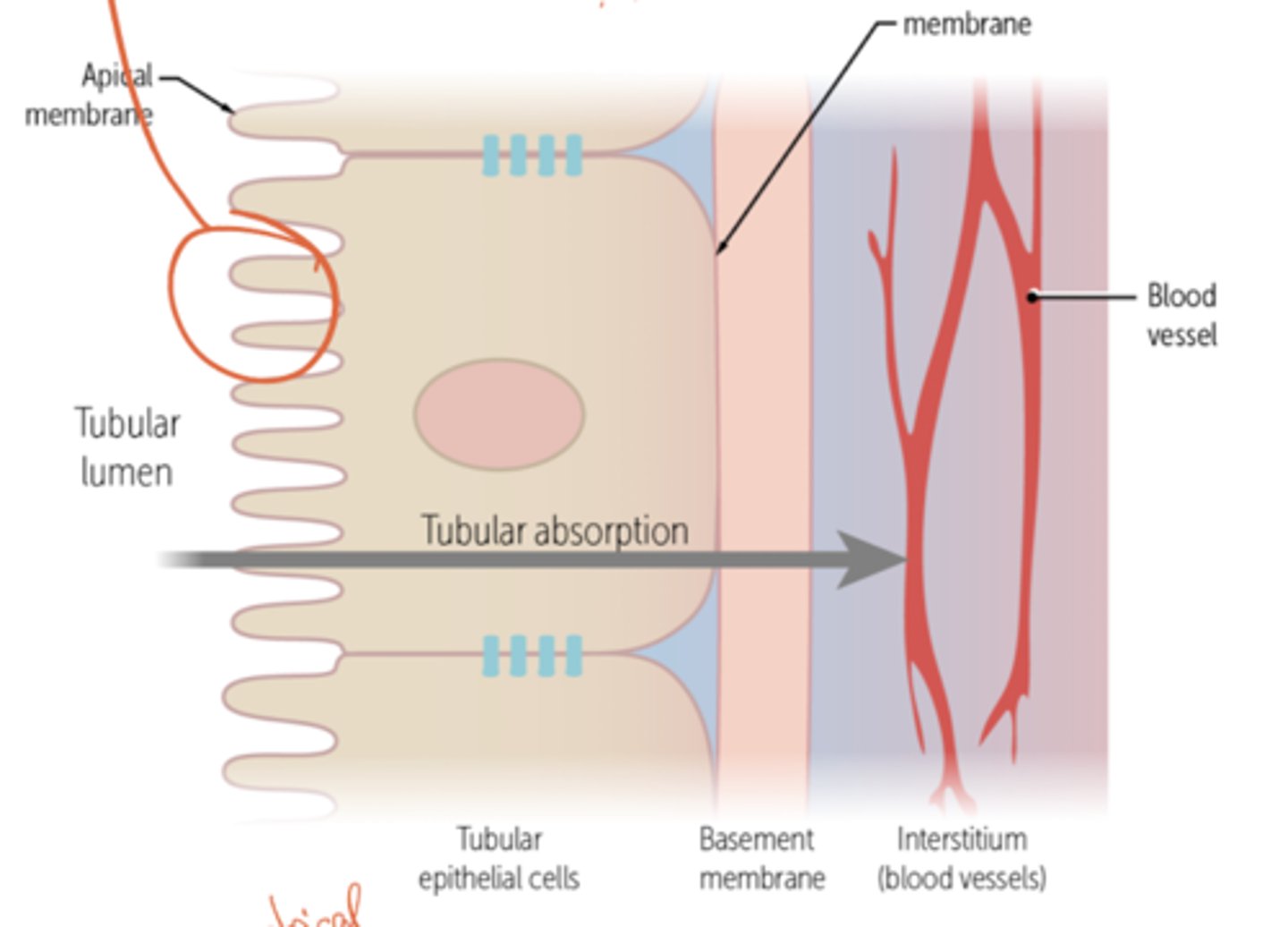
What is the difference between basolateral and apical membranes?
Apical membrane faces the outside environment, while the basolateral membrane faces the inside environment (basal also rests on the basement membrane).
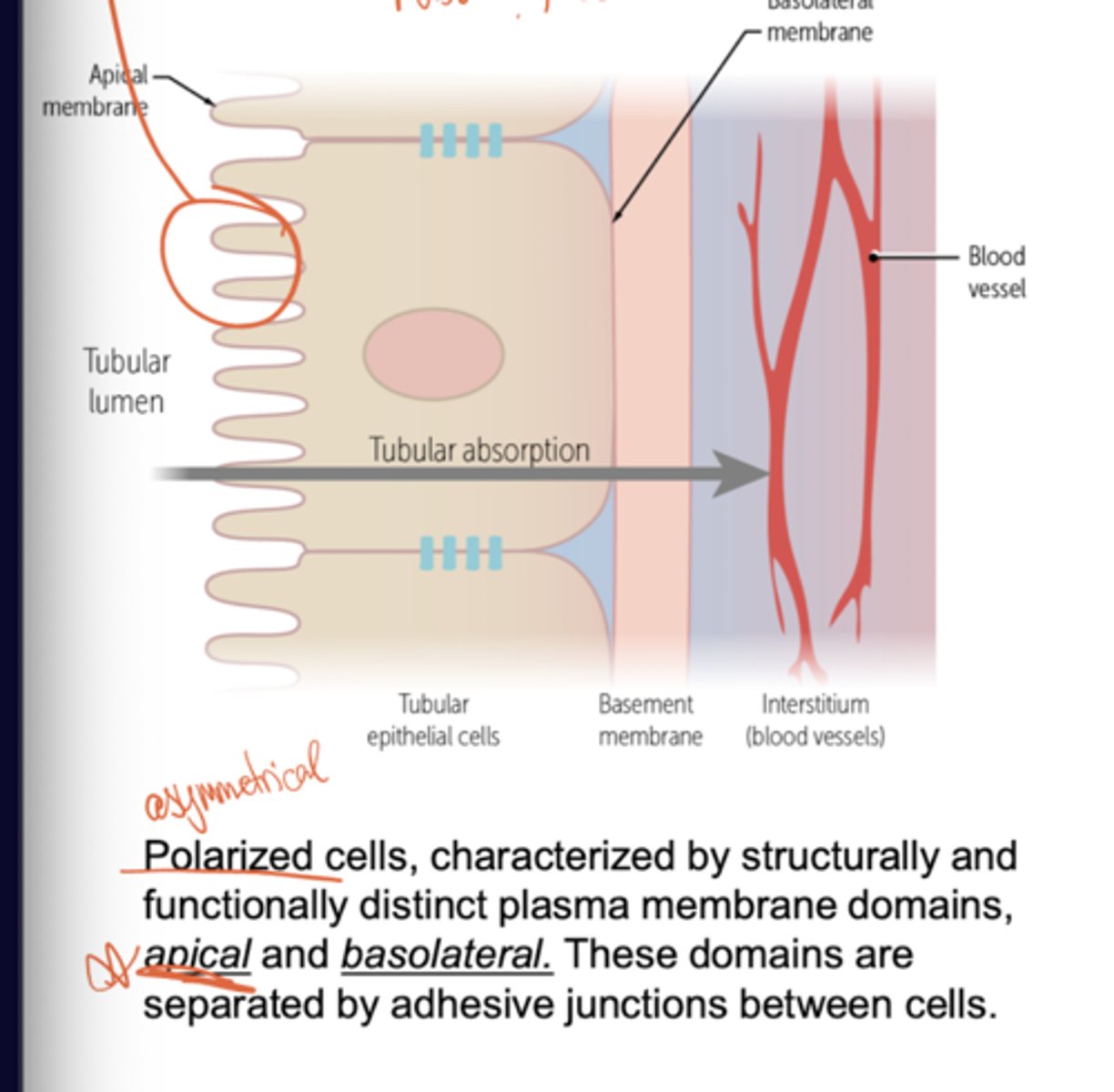
What is the purpose of secretory and absorptive cells and what are some examples?
These produce, absorb, and secrete substances, such as growth factors and cytokines. Examples include digestive cells that selective absorb nutrients
What is the major adhesive junction present in barrier cells?
Tight junctions
What are the typical means of organizations of cells?
Simple squamous, simple cuboidal, simple columnar, pseudo stratified columnar, stratified squamous, stratified columnar, transitional
stratified means layered

Name some examples of barrier tissue present in the body?
Epithelial cells line surfaces of tracts facing the external environment.
Endothelial cells line the surfaces facing internal environment.
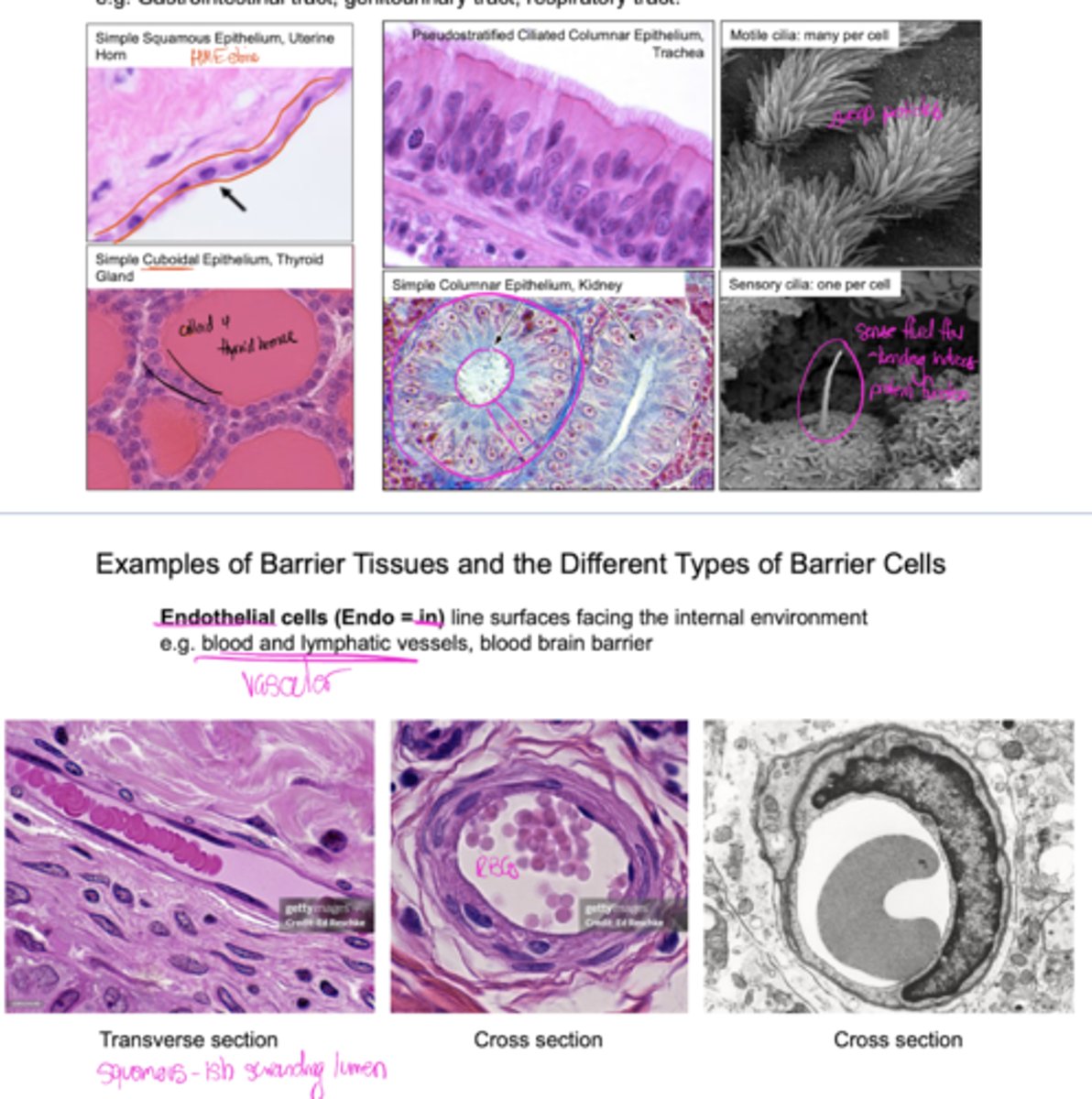
What are the types of contractile cells?
Skeletal muscle, cardiac muscle, smooth muscle, and myoepithelial cells
What are some distinguishing features of skeletal muscle?
These muscles stabilize the skeleton, guard entrances and exits of the GI, respiratory, and urinary tracts
Some distinguishing features include striations present, multinucleated cells, and flat nuclei that are pushed off to the side.
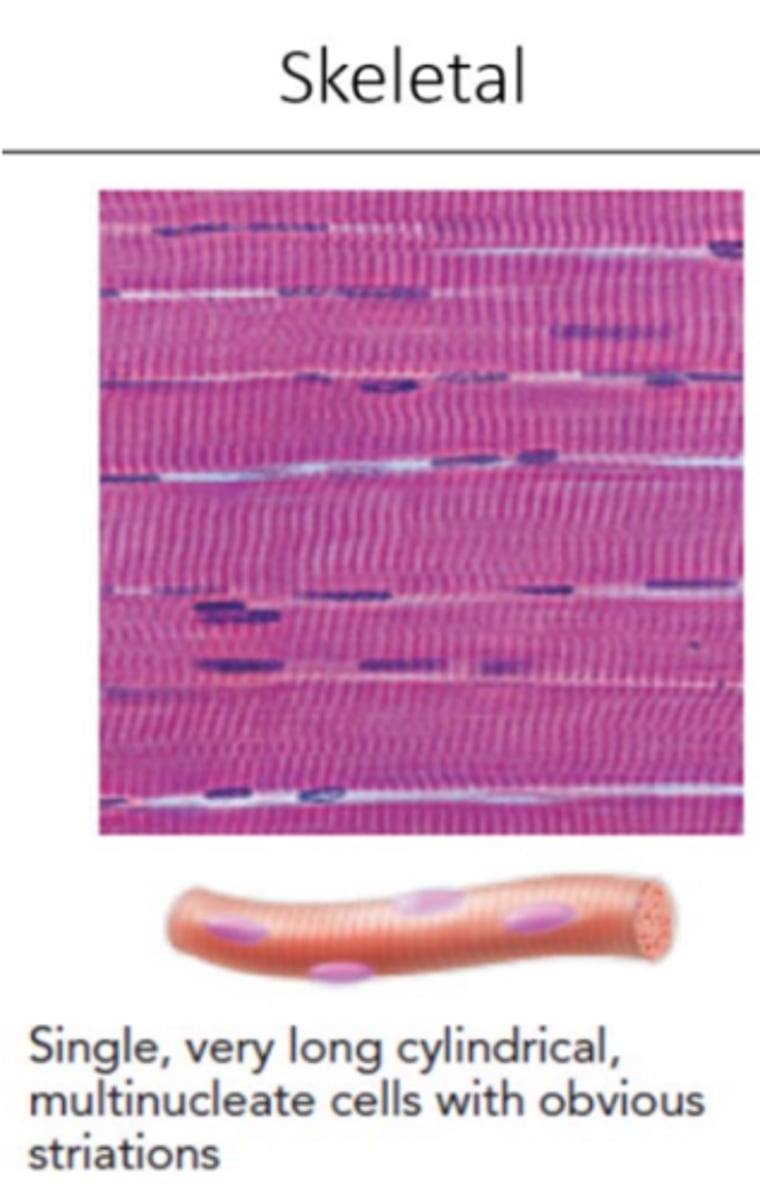
What do straitions represent in skeletal muscle?
They represent alternating myosin and actin strands (sarcomeres) that are responsible for contraction.
What are some distinguishing features of cardiac muscle?
Cardiac muscle typically features branched muscle fibers, striations, and intercalated discs!!!!! (big one)
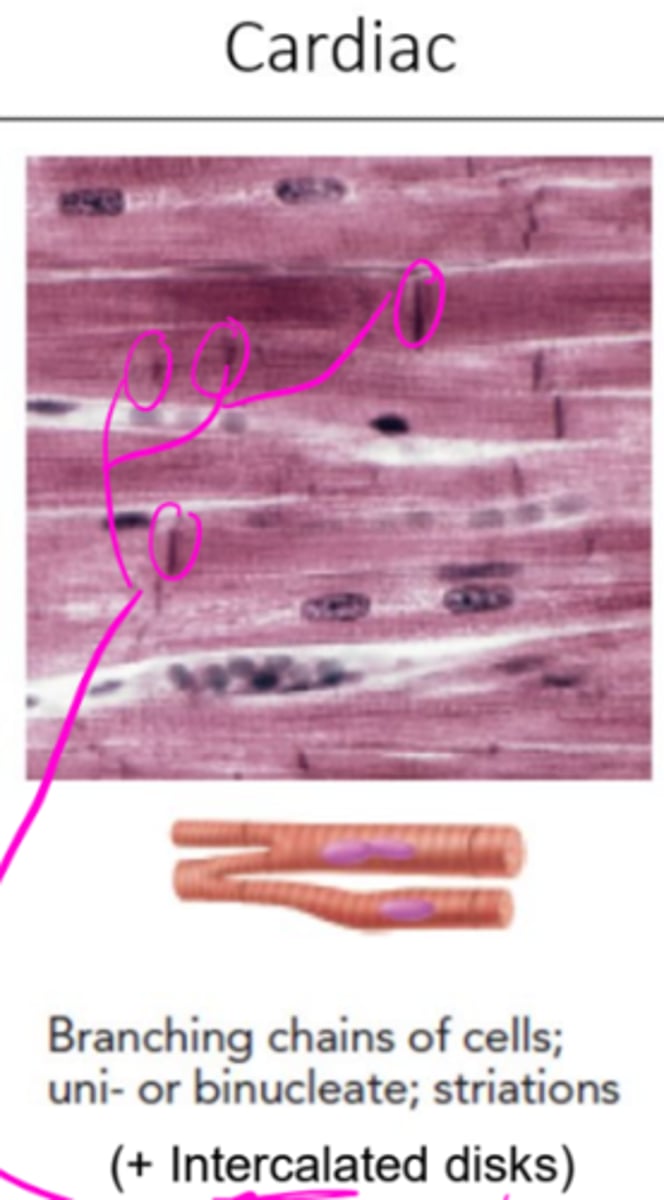
What is the major purpose of intercalated discs found in cardiac muscle?
For coordinating contractions in cardiac muscle
What are some distinguishing features of smooth muscle?
Smooth muscle is located in muscles that contract involuntarily, such as those in the GI tract. These contain autonomic neurons, and spindle shaped muscle fibers. They contain NO striations and are uninucleate
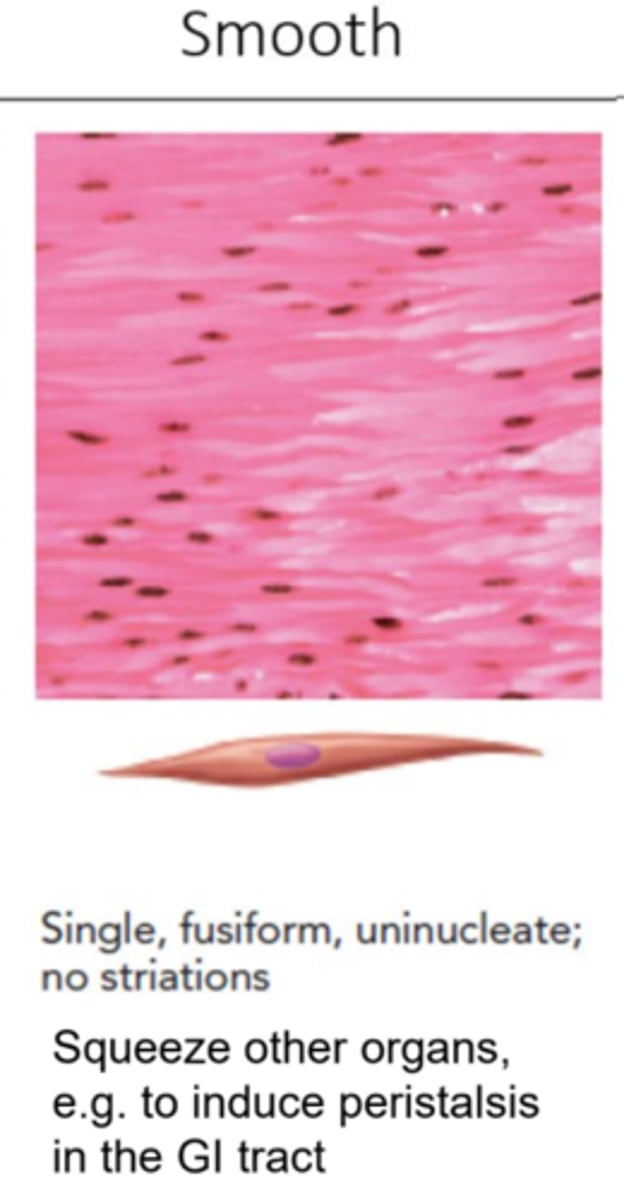
What are some distinguishing features of myoepithelial muscle?
These contractile cells surround secretory glands and allow secretion of whatever they got, such as in the mammary glands, or acinar cells of the pancreas
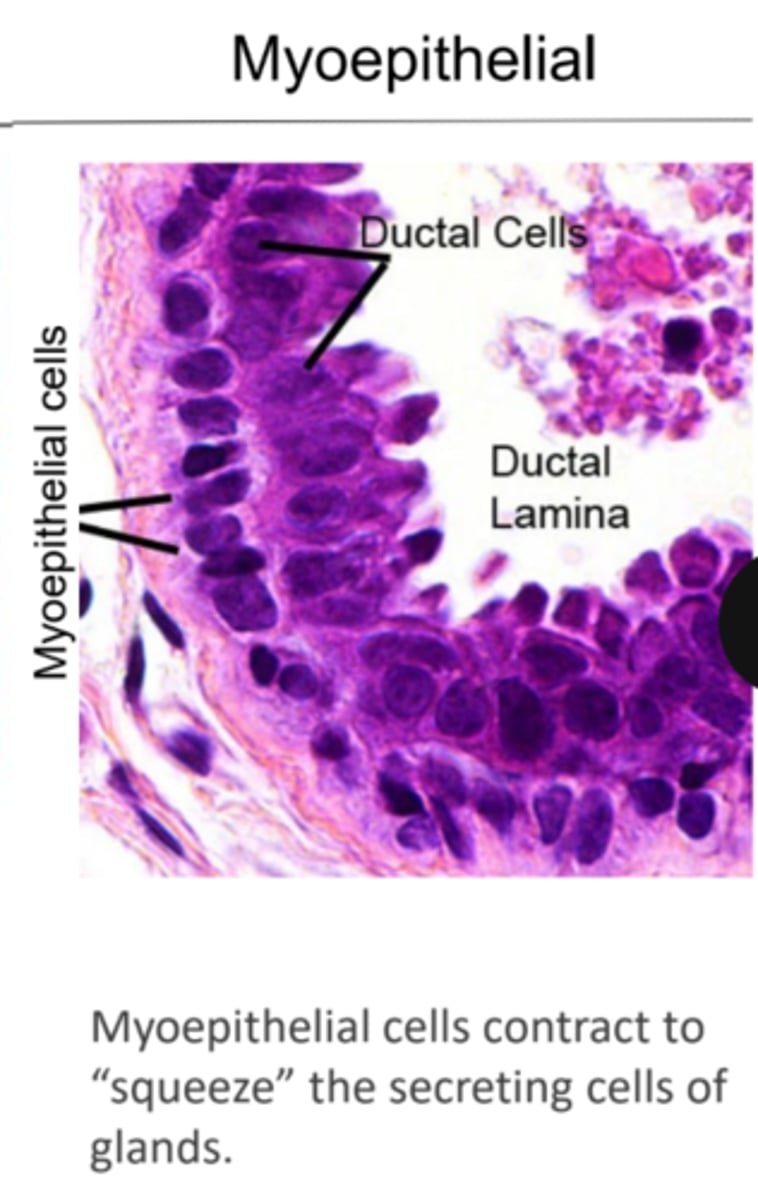
What are some characteristics of signal transmitting cells, specifically neurons?
Neurons are characterized by a single long axonal process that transmits information, and multiple dendritic processes that receive information. They are uninucleate and transfer information between brain cell and other organs.
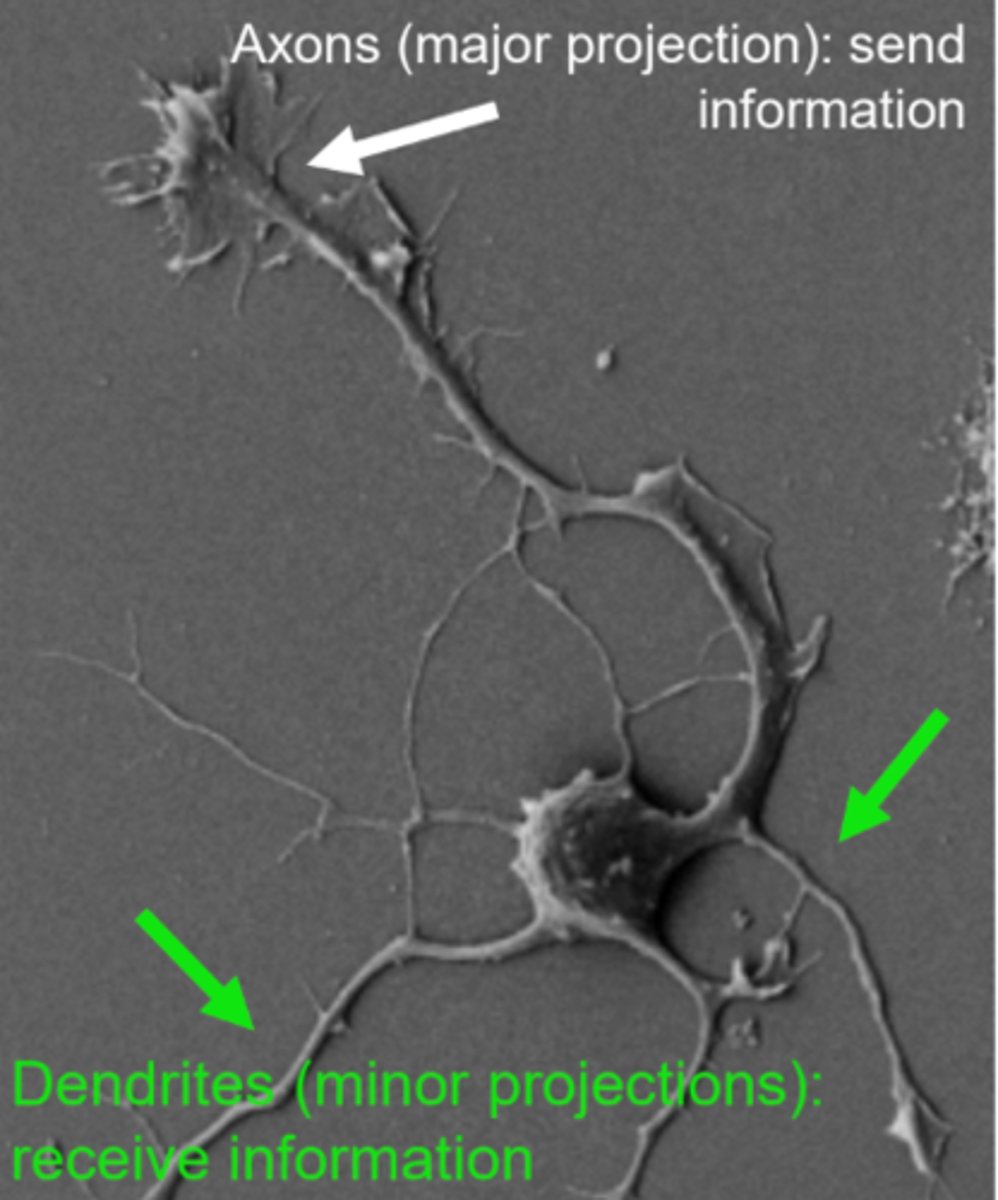
What are the types of connective tissue cells? What do they specialize in doing? What are some characteristics?
Fibroblastic and Mesenchymal cells; they secrete extracellular matrix proteins.
They are fried egg or spindle shaped, characterized by extensive ROUGH ER.
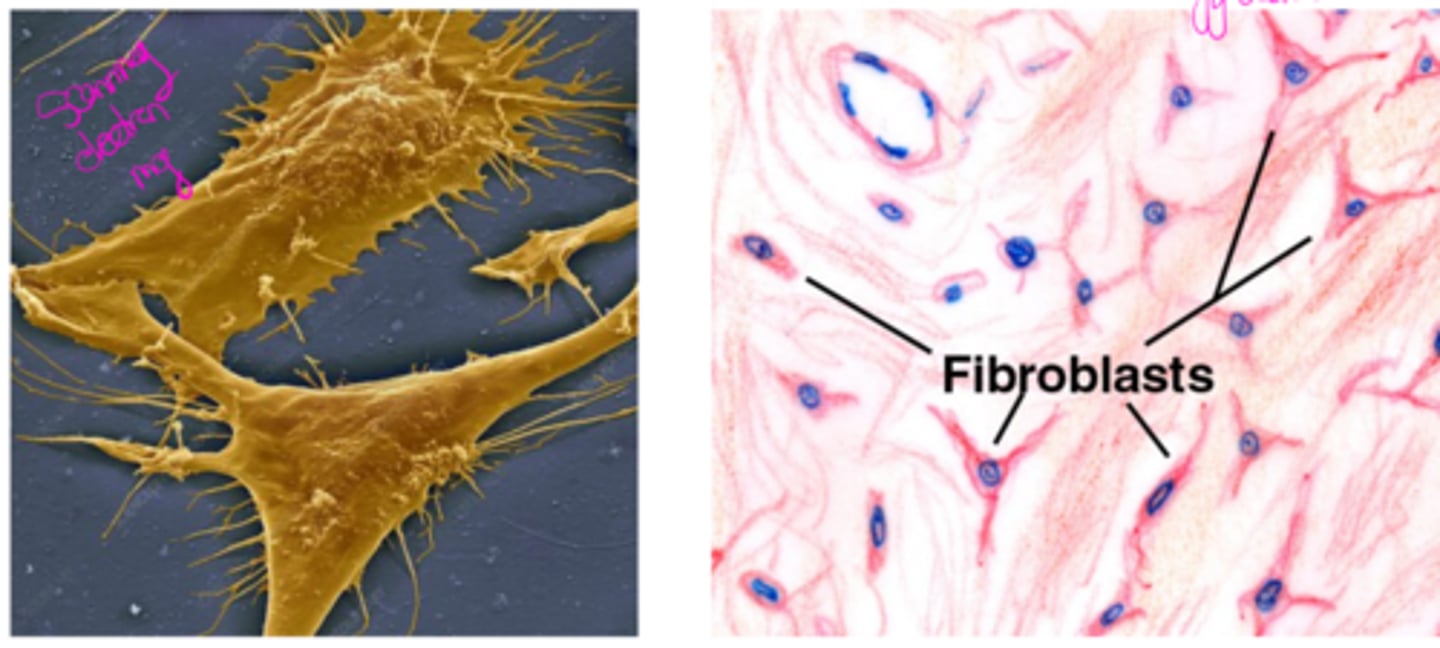
What are the energy storing cells? What form of energy do they each store?
Adipocytes (triacylglycerols), and Skeletal Muscle (glycogen).
What are some characteristics of adipocytes?
They are characterized by a clear appearance, with nuclei appearing off to the side
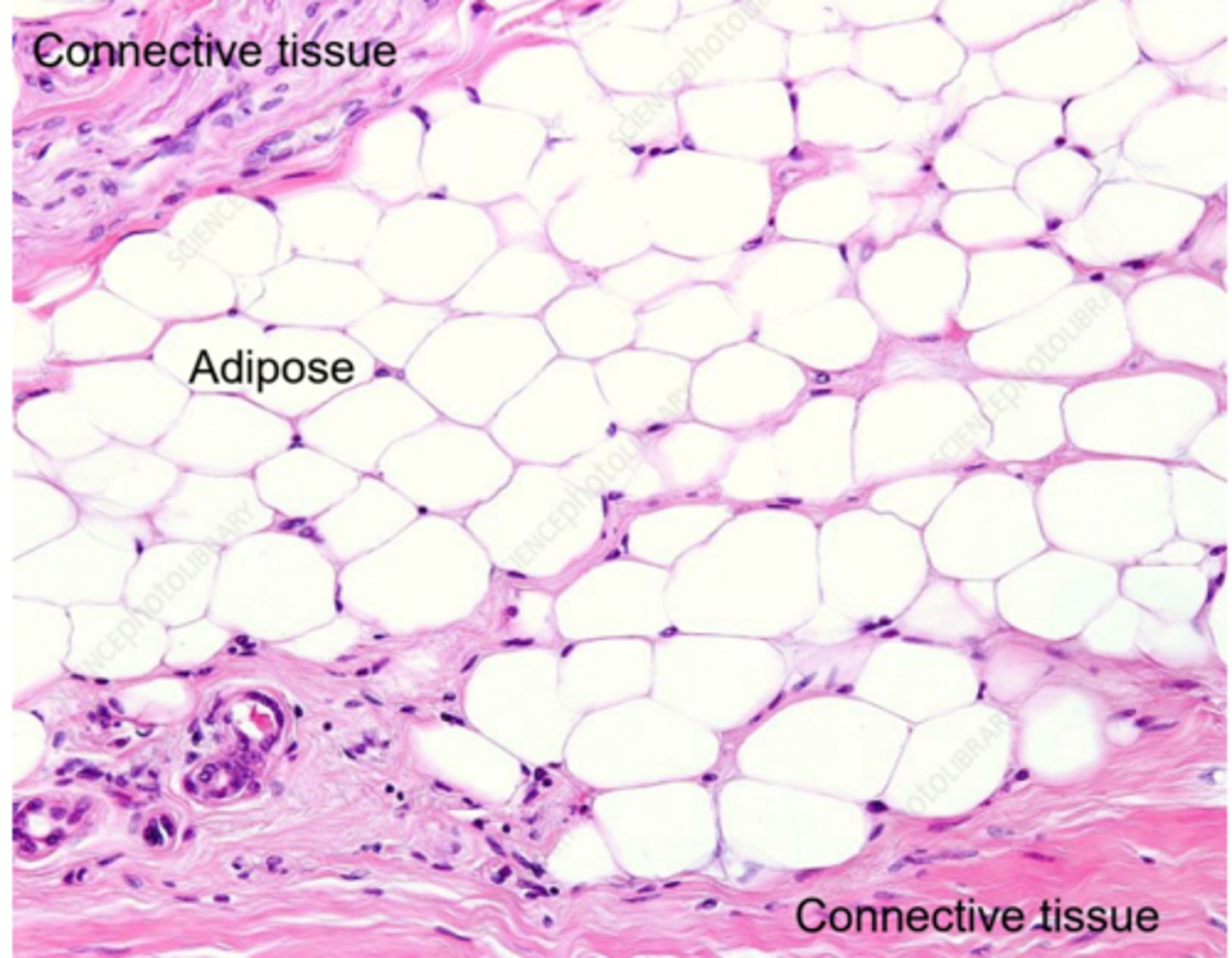
What are the meanings of totipotent, pluripotent, multipotent, committed, and differentiated cells?
Totipotent - capable of creating all types of cells
Pluripotent - capable of creating most types of cells
Multipotent - capable of creating cells of a certain lineage
Committed - almost differentiated cells; a form of transit-amplifying cell
Differentiated/Unipotent - cell with a specific function and not able to create any other type of cell
In which stage of development do cells lose totipotency?
During early embryogenesis after the 16 cell mark. After this, most cells are pluripotent.
What are transit-amplifying cells?
stem cells that have begun to differentiate but rapidly divide before fully differentiated to replace tissues quickly; this protects the stem cell population by creating many cells from one stem cell
What are the three germ layers that form during gastrulation?
Gastrulation is a fundamental process of embryonic development where a blastula (a single layer of cells) reorganizes into a three-layered structure called a gastrula
Ectoderm (outside later), mesoderm (middle layer), and endoderm (internal layer)
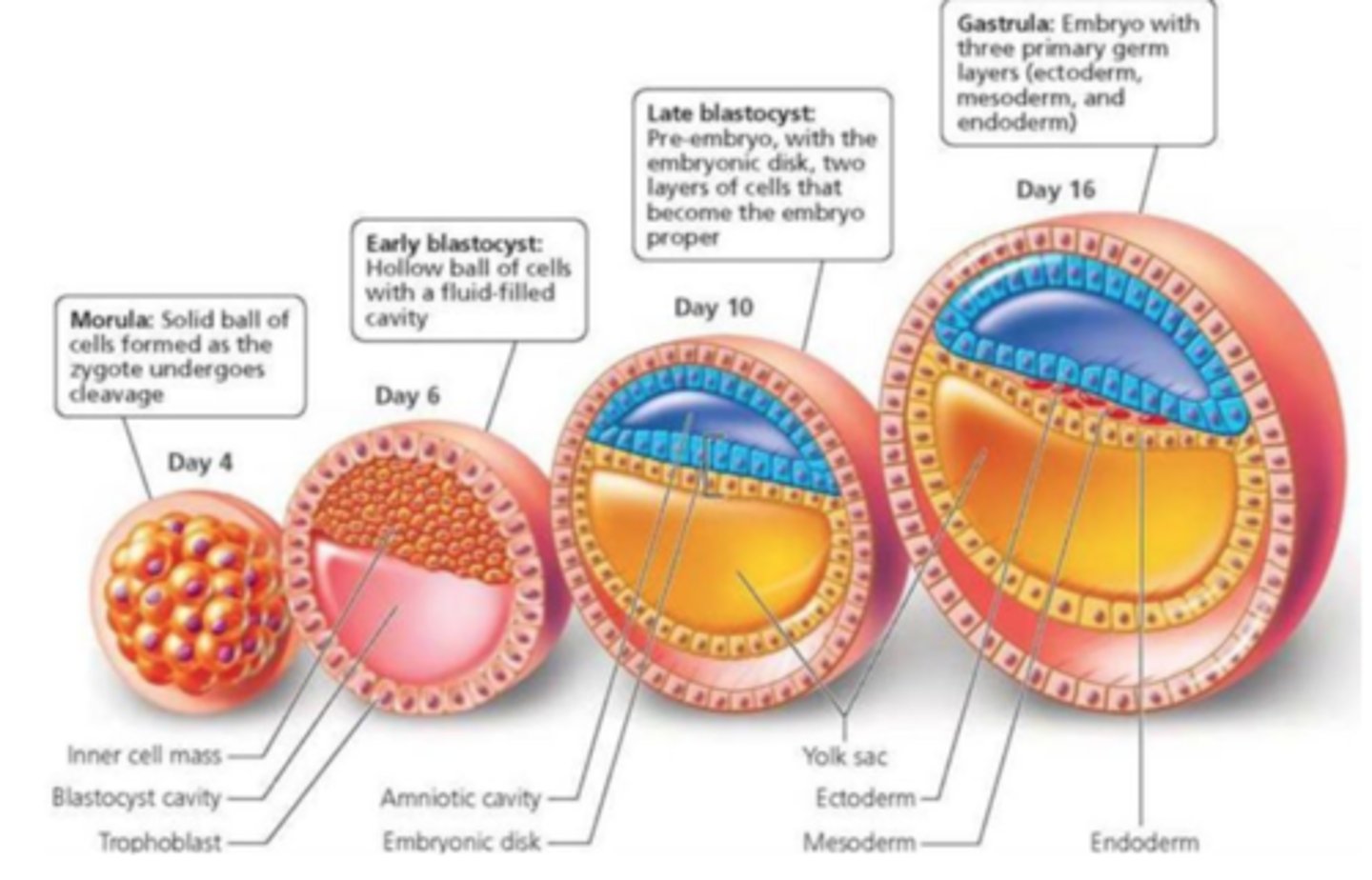
How can you tell adipose and lung epithelium (both cells with large empty spaces) apart?
Lung epithelium form a squamous lining layer, with nuclei pushed to the side. Adipocytes have one nucleus that is pushed off to the sides.
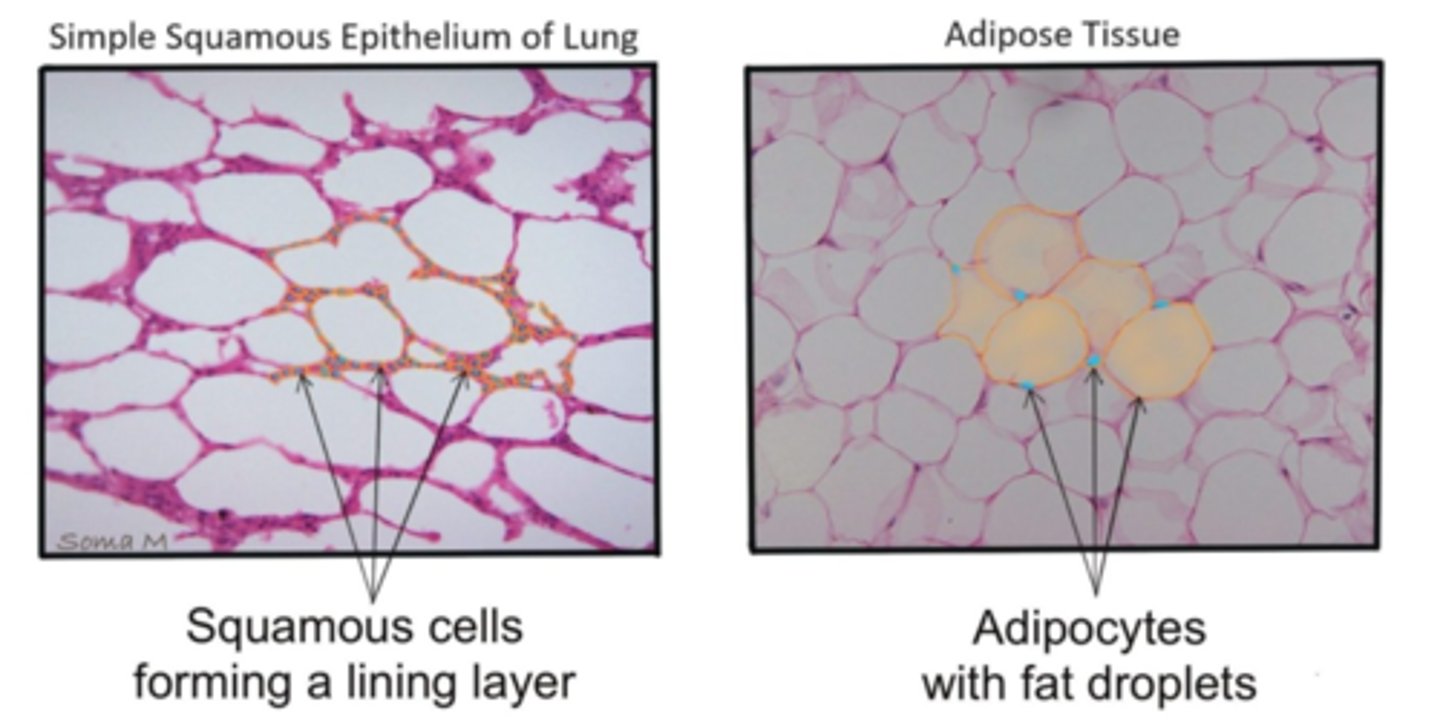
What is the difference between cell proliferation and cell differentiation?
Cell proliferation is the growth of a cell that contributes to the growth of organs, including cell replacement and growth.
Cell differentiation involves the renewal and specialization after creation from a stem cell.
How do embryonic stem cells and adult stem cells differ?
Embryonic stem cells can proliferate rapidly and have the ability to differentiate into all cell types in an organism, meaning totipotent.
Adult stem cells only differentiate into various cells of a specific lineage, being multipotent or even unipotent
What stage of the cell cycle are adult cells typically in? What is another word for this?
G0; quiescent cells
What are the differences between totipotent, pluripotent, multipotent, and unipotent stem cells?
Totipotent: have the potential to develop into a complete organism, including supportive tissues
Pluripotent: have the potential to become any of the germ layers
Multipotent: lineage committed cells with potential to give rise to all cells of the germ layer
Unipotent: committed cells that give rise to only one cell type
What are induced pluripotent stem cells?
Adult stem cells that have been reprogrammed by introducing extra copies of genes that control pluripotency.
What are the two classes of cells based on proliferative (growth) potential?
Resting/Quiescent cells (mitotically inactive but can resume)
Postmitotic cells: left cell cycle and are incapable of cell division individually (like perma G0; ex, neurons, cardiac and skeletal muscle, mature WBCs, and RBCs)
NOTE: hematopoietic cells are postmitotic, but are renewing via stem cells in bone marrow and whatnot
What is the result in gene expression changes in cells of a specific lineage?
Cells are committed to a specific lineage. This generates progenitor cells of a particular tissue (only able to repopulate the specific cells of that tissue)
Name some examples of places from which one can find post-mitotic cells in a human adult?
(cells that have permanently exited the cell cycle and are no longer capable of dividing)
Some examples include brain neuronal cells, skeletal muscle, cardiac muscle
Name some examples of places from which one can find renewing cells in a human adult?
Hematopoietic cells (blood cells and such) are constantly renewing
Name some examples of places from which one can find minimally committed adult stem cells in a human adult?
Bone marrow (make hematopoietic cells), testis (sex cells), intestines (intestinal epithelial cells are constantly turned over), skin (same reason as intestine), and hair follicle (duh)
What are some examples of mesenchymal stem cells (MSCs)? What does this mean?
They are multipotent non-marrow tissues.
Some examples include, cartilage (chondrocytes), bone (osteocytes), tendon/ligament (fibroblasts), fat (adipocytes), marrow (stromal cells), CNS (astrocytes), skin (fibroblasts), and muscles (myocytes)
What are the three possible outcomes of cell division?
Symmetric stem cells (2 new same cells), Symmetric committed cells (2 new same cells but not stem cells), and asymmetric (1 stem cell + 1 committed cell)
What determines if cell division is symmetric or asymmetric?
The plane of division. This can either split the apical and basal membrane of the mother cell directly in half, OR it can split the basal membrane into one daughter, and the apical membrane into another
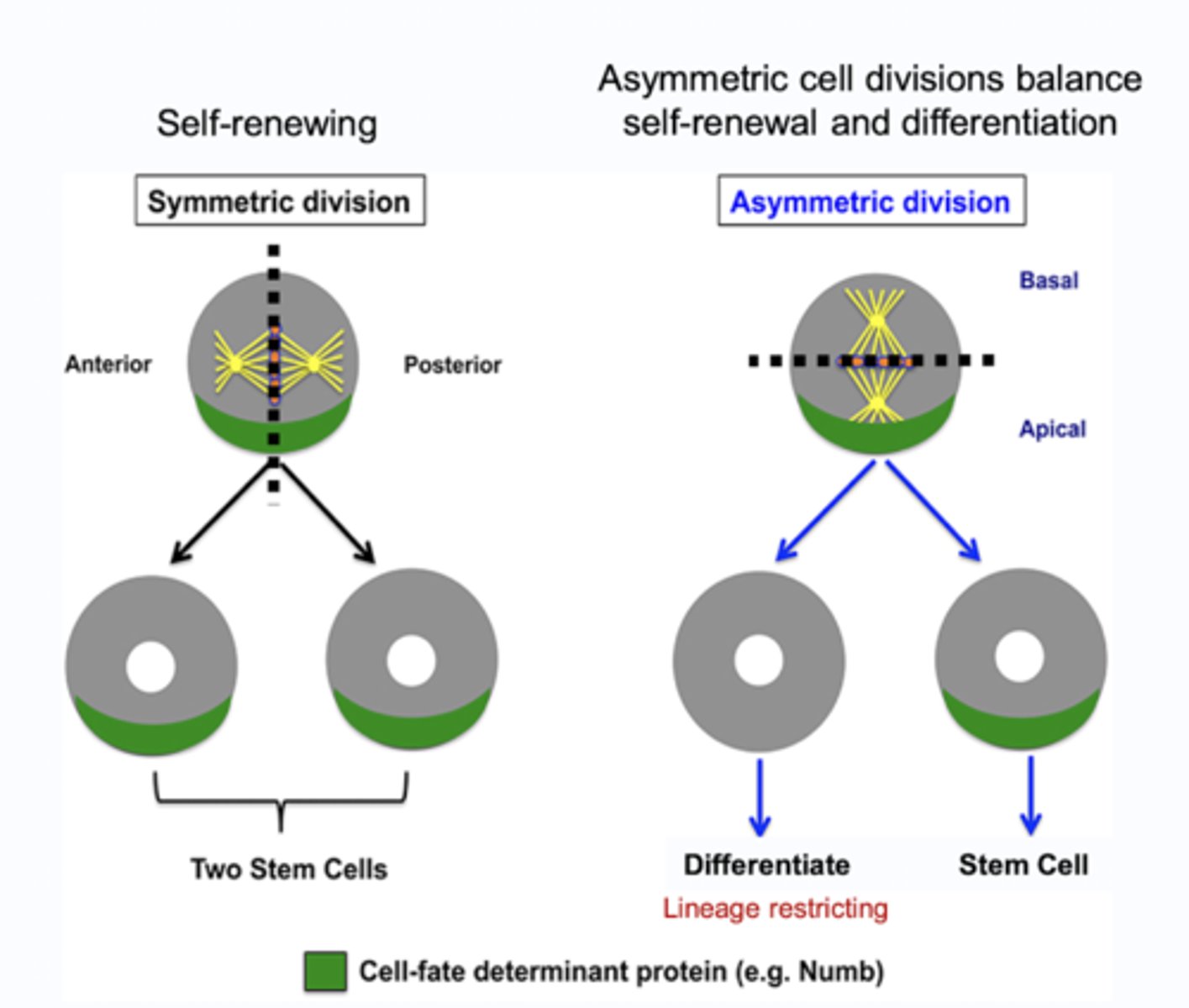
What are some extrinsic factors that control stem cell committment?
Extrinsic factors include chemical signals and physical environment.
Some chemical signals include growth factors and hormones.
Some physical environment features include the substratum (i.e. basement membrane), extracellular matrix, and cell-cell adhesion (like in cell plate cultures).
What are some intrinsic factors that control stem cell committment?
Intrinsic factors include genetic, epigenetic, and proteins (those that dictate cell polarity, as on apical and basal membranes)
How do extrinsic and intrinsic asymmetry differ?
As mentioned, extrinsic asymmetry is affected by the cell's external environment, that being something like a basement membrane.
Intrinsic asymmetry is affected by the cell's internal environment, such as proteins on the apical or basolateral membranes that make it polarized.
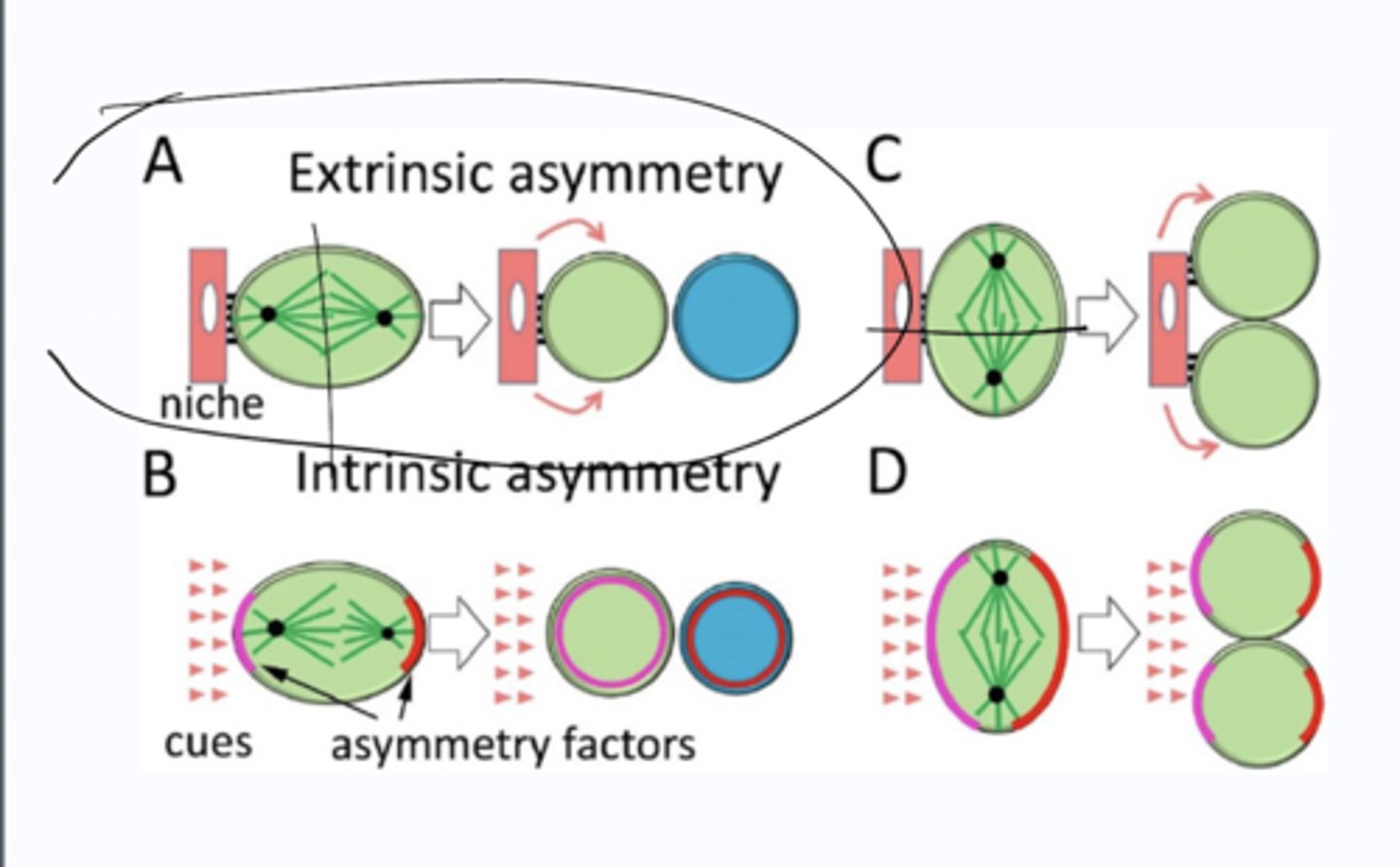
What are some of the key reprogramming factors involved in reprogramming adult somatic cells?
Oct3/4, Sox2, Klf4, and c-Myc
What is another term for cellular reprogramming in terms of differentiation?
Transdifferentiation is the possibility that somatic cells can be reprogrammed into other types of differentiated cells
What are transit amplifying cells?
Stem cells that have committed to their pathway to differentiation, but have not become unipotent yet
Describe how and why intestinal epithelial cells are constantly renewing?
Stem cells exist at the bottom of crypts that create transit amplifying cells that travel to the surface of villi as old IECs are shed.
They renew because being a cell is hard :(
Also in order to permit gut health.
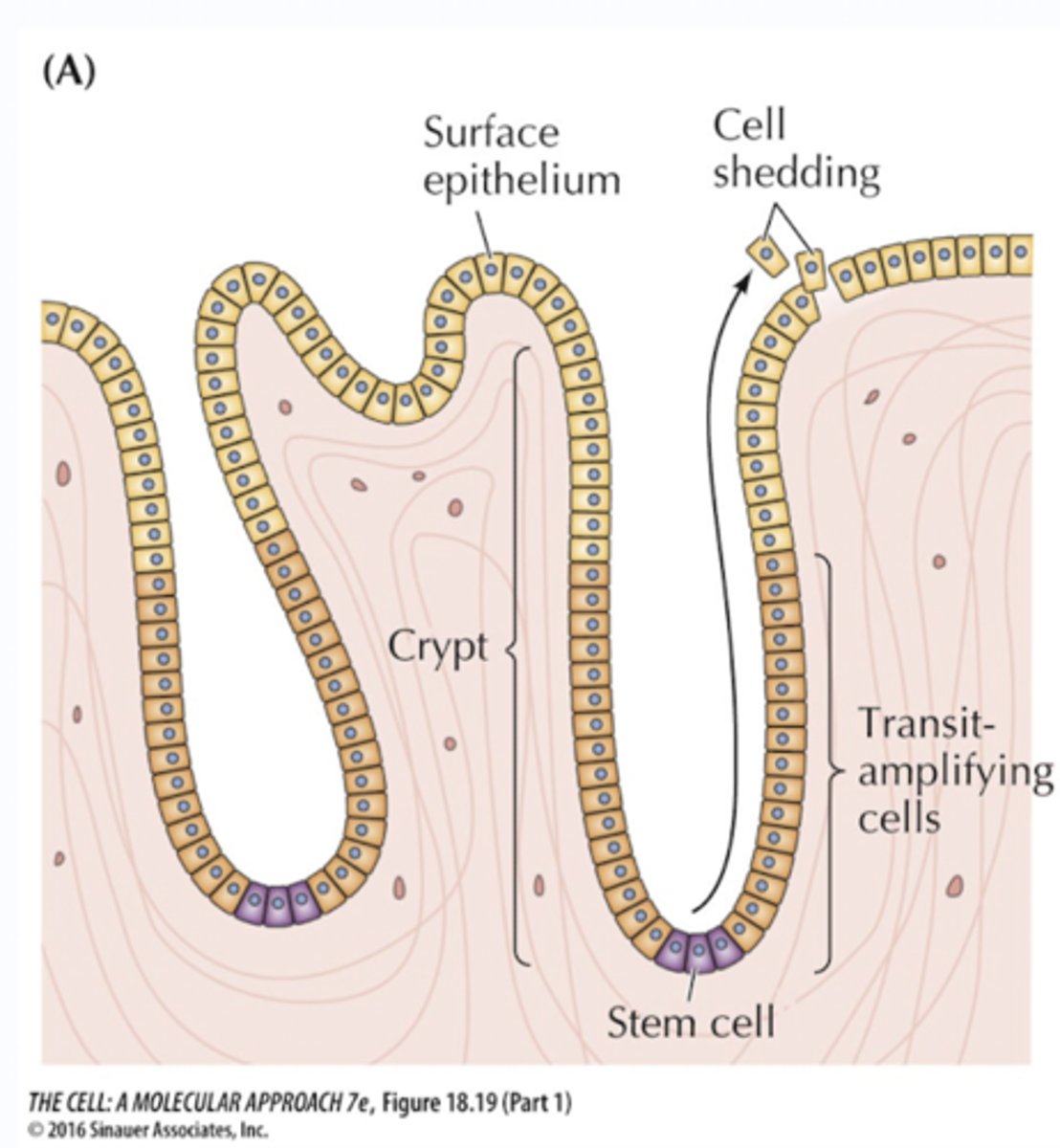
What is unique about liver epithelial cells?
They are normally quiescent, but are stimulated to proliferate if large numbers of liver cells are lost
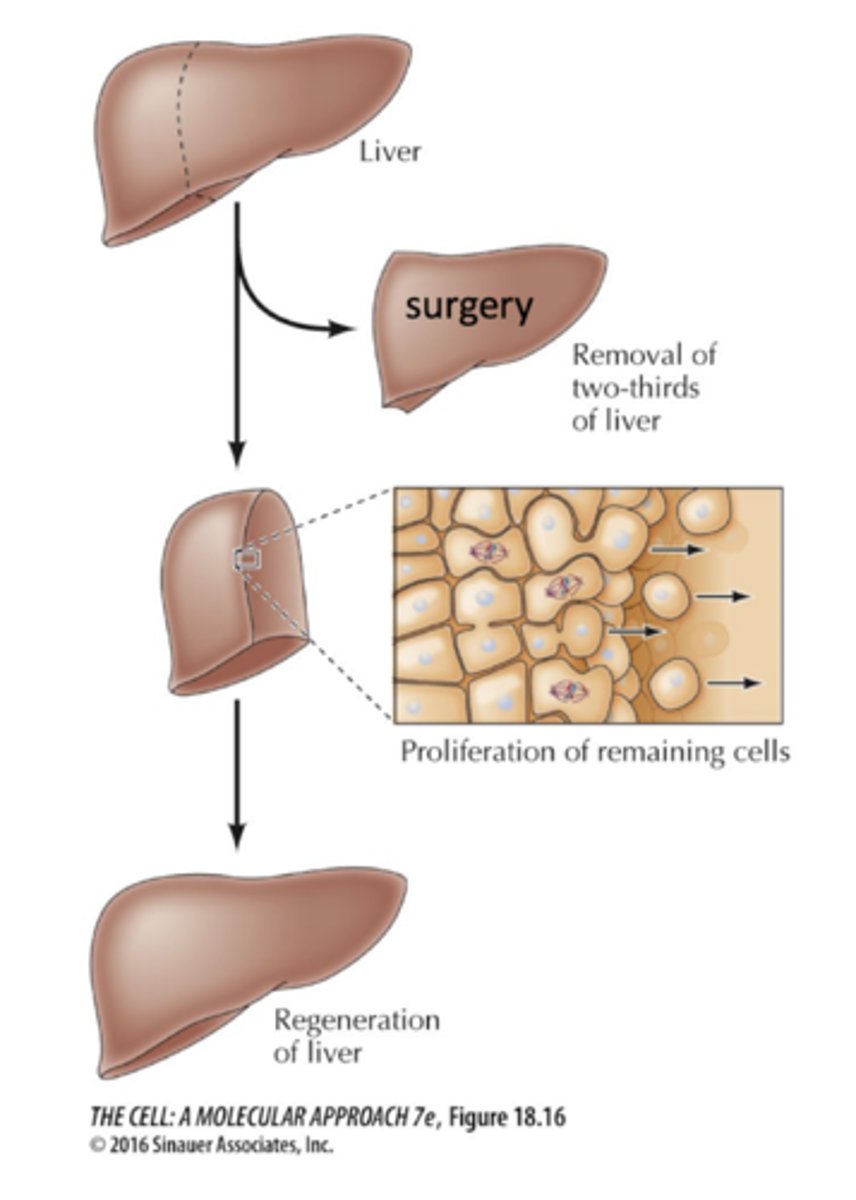
What are the stem calls of adult muscle? When do they proliferate?
They usually hve little cell turnover, but regenerate from satellite cells (muscle stem cells) in response to injury.
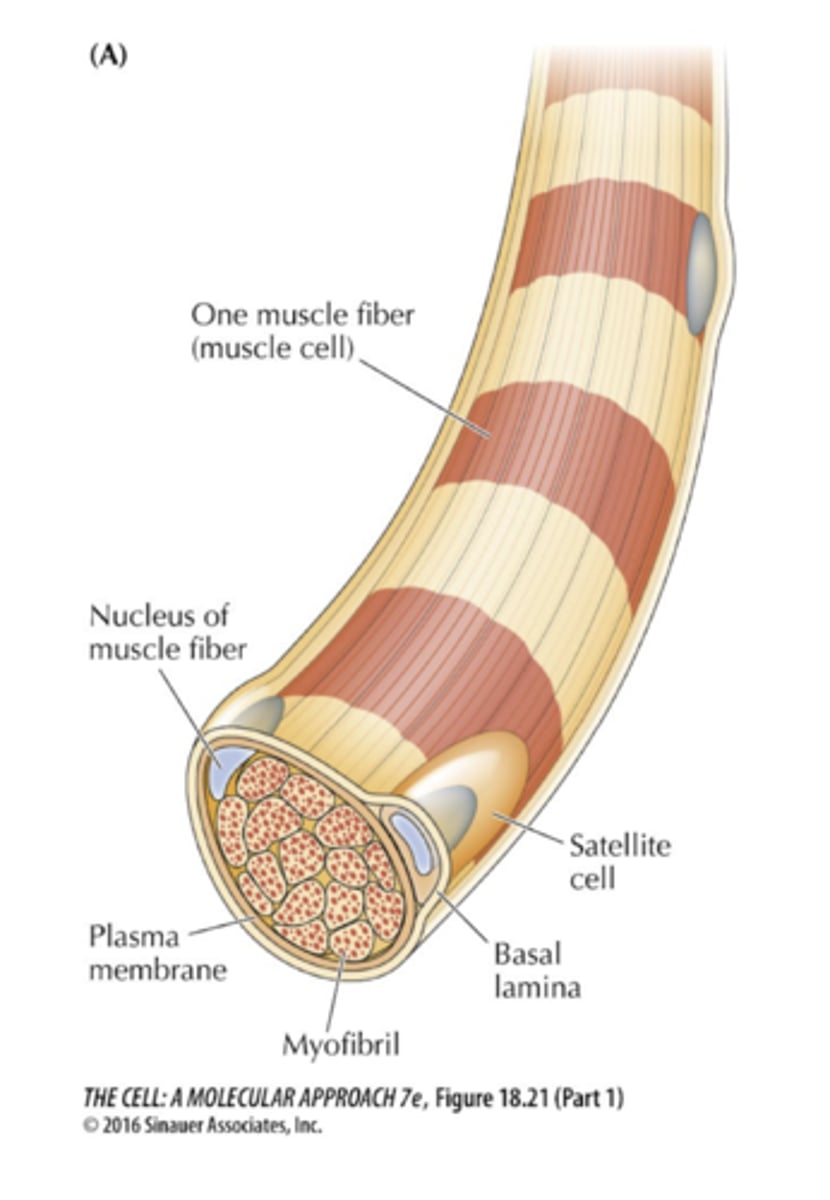
What is the endoplasmic reticulum referred to in myocytes?
Called sarcoplasmic reticulum, in muscle cells, and the Ca2+ release and uptake is involved in muscle contraction
What do H&E stains do respectively?
Haematoxylin (H), is a blue dye that binds to negatively charged molecules, like DNA and RNA, because it stains basophillic (acidic) structures.
Eosin binds to positively charged mitochondria and stains them pink because it stains acidophillic (basic) structures.
What is metaplasia?
a switch that occurs in tissue differentiation that converts one cell type to another, altering its functional ability
What is a stem cell niche?
Microenvironment around stem cells that provides support and signals regulating self-renewal and differentiation
How is a stem cell niche maintained?
Integrin-mediated attachment (a protein that links a cell to its ECM) between stem cells and other cell types maintains a niche
How is an image formed in light microscopy?
An image is formed by alteration of light waves to generate visible contrast (through a light medium).
How is an image formed in transmission electron microscopy?
Am image is formed by passing an accelerated electron beam through a specimen to a phosphor screen.
Denser samples absorb electrons from the beam, making them appear darker and provide contrast.
How is an image formed in scanning electron microscopy?
An image is formed by scanning a focused electron beam over specimens.
Electrons interact with atoms of the sample surface, generating a scatter that is used to generate a 3D image.
What are the three crucial methods that allow visibility of cells in light microscopy?
Contrast: creating differences in light intensity between specimen and background
Magnification: ability to produce an image larger in scale than actual size
Resolution: ability to distinguish detail
What is cell fixation? Why is it done? What are the three methods of doing this? How do they differ?
A cell sample is treated with agents that kill the cells and fix their proteins, lipids, and DNA in place.
This prevents degradation, provides a temporal snapshot, and allows the observation of specific proteins.
Alcohols and acetone permeates the cell membrane. Aldehydes preserve the membrane.
Why is permeability important in the fixation of cells?
Antibody tracking of particular proteins may be hindered if using a fixative that preserves cell membrane rigidity (aldehydes).
What is the process of the preparation of histological tissue samples?
A tissue is fixed, dehydrated, cleared, infiltrated, and embedded in resin, which is then cut into thin sections by a microtome to be mounted on slides.
What is the relationship between wavelength and resolution?
As wavelength decreases, resolution increases, and as it increases, resolution decreases.
What is the Rayleigh Criterion?
Two objects can be resolved if the valley between the overlapping brightness maxima is reduced by >20% compared to the maxima.
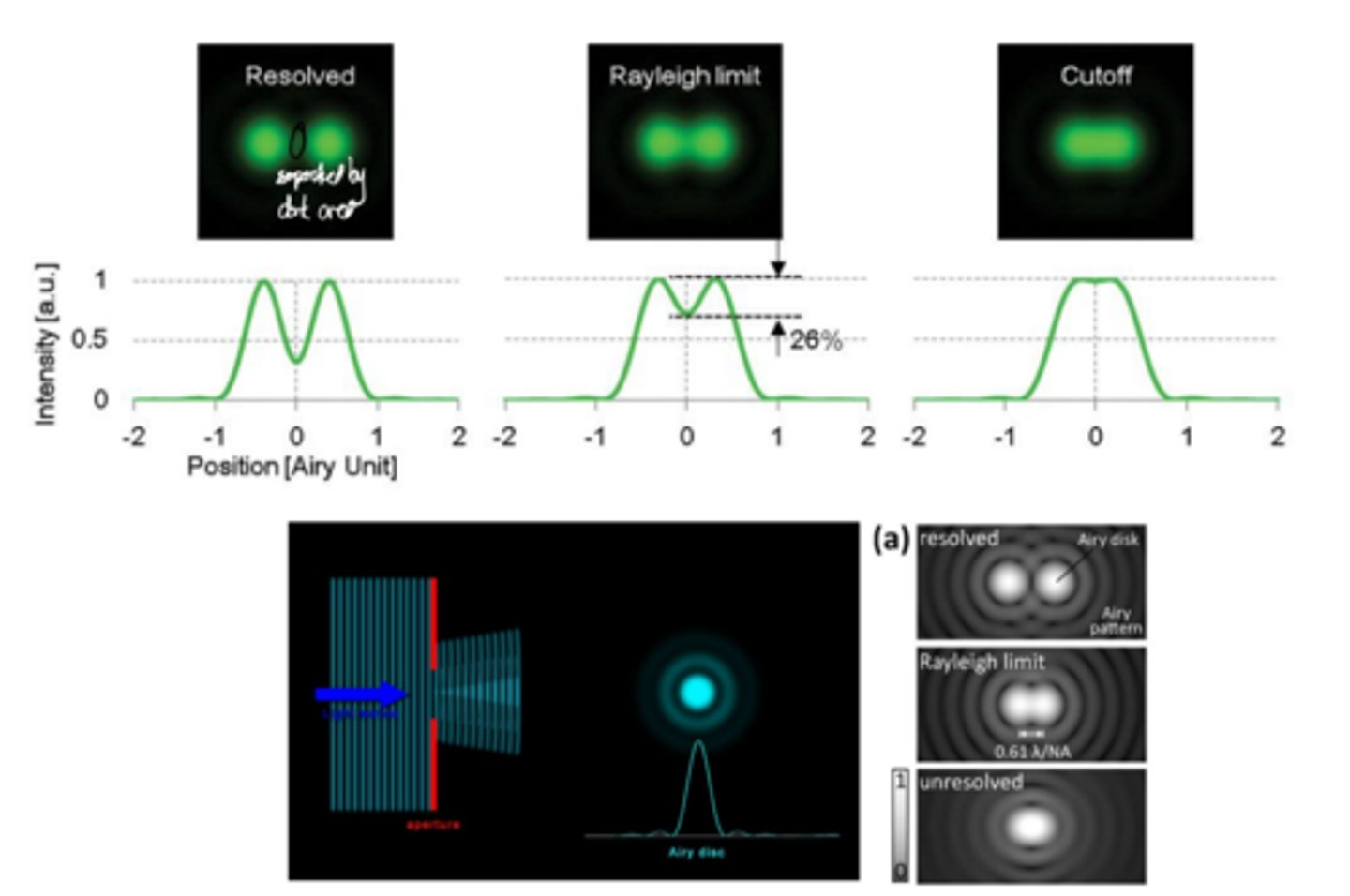
What are the two common microscope components that are used to generate contrast?
Phase optics, and differential interference contrast (DIC) optics
What is PAS staining?
PAS staining, or Periodic acid-Schiff staining, is a histological staining technique used to visualize carbohydrates, glycogen, mucosubstances, and other carbohydrate-rich macromolecules in tissue samples.
It colors than bright magenta or purplish-red.
What is oil red O staining?
Used to stain neutral lipids (triglycerides and cholesterol esters) and colors them red.
What is trichrome staining?
A histological staining technique used to differentiate muscle tissue, connective tissue, and nuclei.
What is the benefits of generating contrast with fluorescence?
Adds specificity in molecules, sensitivity to recognition, spatial, and temporal resolution.
What are the characteristics of samples used in viewing immunological reactants?
Immunofluorescence imaging uses antibodies to recognize proteins, thus requiring a fixed sample
What are GFPs? How are they used in imaging?
Green fluorescent protein can be fused to any protein of interest using recombinant DNA methods and can be expressed in cells and detected
How are phase contrast and DIC methods in light microscopy distinguished?
DIC generates a 3D appearing image; almost appearing metallic
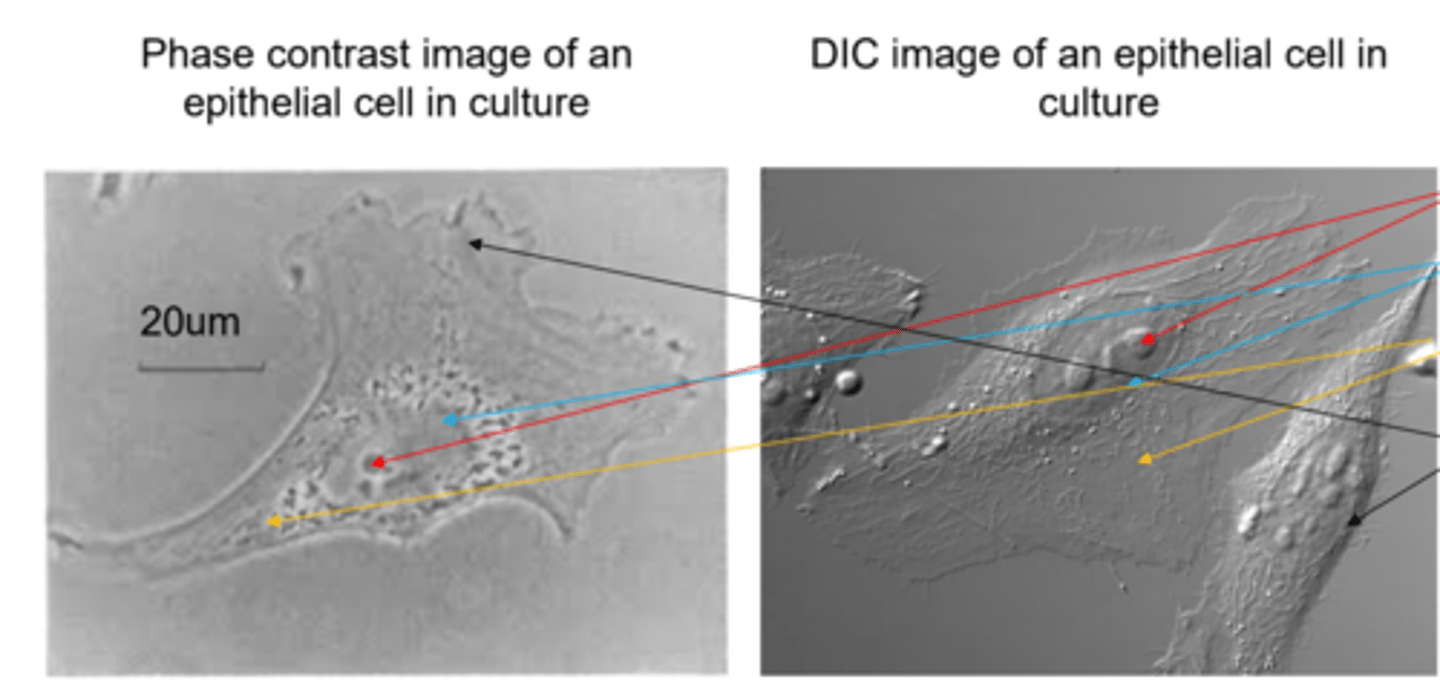
What type of image can be created with transmission electron microscopy?
Generates a finely detailed 2D image, with denser objects appearing darker
Why is depth important to consider in imaging?
The different possible cross-sections of cell can alter the appearance of certain organelles and structures (such as nuclei and mitochondria)
How is immunolabeling similar and different in TEM?
Immunogold, or heavy metal ions, are used to detect particular proteins and organelles
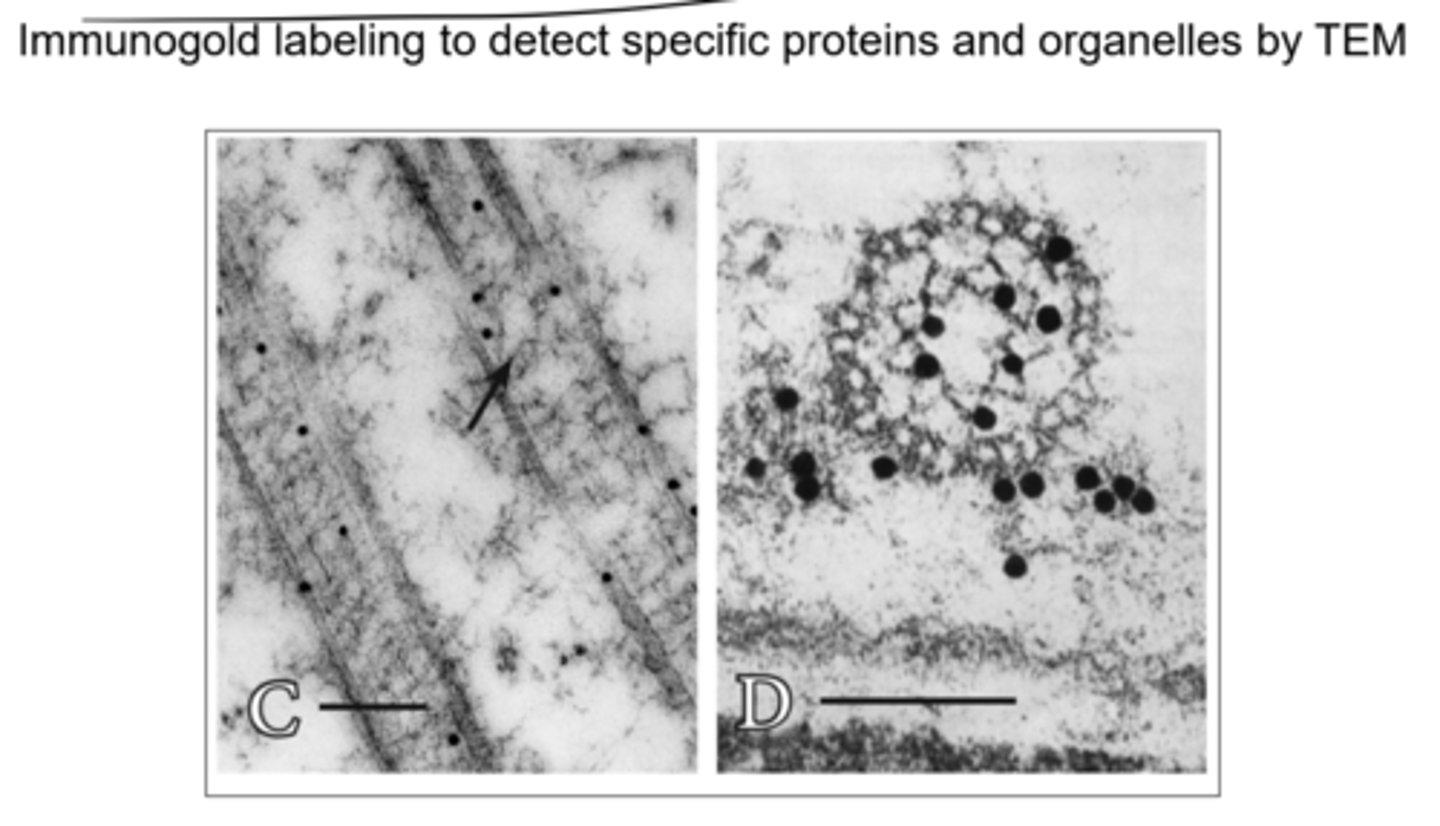
What is visible in scanning electron microscopy?
Reveals surface features of cells
What is visible in freeze fracture etching + scanning electron microscopy?
Allows the 3D view of the interior of cells
Why is electron microscopy have better resolution than light microscopy?
Electrons have a shorter wavelength than light
What function process do the plasma membrane and intracellular membranes work together to accomplish?
Delineation of functional units; this is to keep cells separate from other cells, and prevent mixing of incompatible components (such as lysosomal enzymes)
What function process do the nucleus and cytoplasm work together to accomplish?
These involve mRNA processing, ribosome assembly, and protein translation (central dogma)
What function process do the cytosol and mitochondria work together to accomplish?
They are responsible for fuel consumption and energy production (via glycolysis and respiration)
What function process do the rough ER, golgi, and transport vesicles work together to accomplish?
Protein synthesis, processing, and delivery
What function process do the endosomes, lysosomes, and autophagosomes work together to accomplish?
Protein/membrane retrieval, protein degradation, signal termination
What function process do the cytoskeleton, cytoskeletal motor proteins, and cytosol work together to accomplish?
Organization of organelles, directed movement of proteins, mRNA and organelles, plasma membrane anchoring, and cell shape
What is the role of the plasma membrane?
Delineates the cell; functional boundary
What is the role of the nucleus?
To contain genetic material and transcriptional machinery
What is the role of the nucleolus?
rRNA synthesis and ribosome biogenesis
What is the role of the rough ER?
Synthesis and initial modification of membrane and secretory proteins
What is the role of the smooth ER?
Lipid synthesis, toxin metabolism, and Ca2+ storage
What is the role of the ribosomes?
Protein synthesis
What is the role of the golgi body?
Modification and sorting of proteins
What is the role of the mitochondria?
Oxidation of fuels (fatty acids and carbohydrates) to produce ATP, cardiolipin synthesis, steroid hormone synthesis.
What is the role of the peroxisome?
Destroys peroxides and oxidizes very long chain fatty acids
What is the role of the cilia/flagella?
Cell propulsion and environmental sensing
What is the role of the lysosome?
Digesting cellular proteins and waste
What is the role of the centriole?
Organizes microtubules
What is the role of cytoskeleton?
Defines cell shape, organizes cytoplasm, and links to adhesion molecules
What is the role of the cytosol?
Contains enzymes, modifying proteins, ATP, and GTP
How is the process of endocytosis conducted?
Receptors on the cell's surface bind ligands, leading to the formation of invaginations that create structures such as clathrin coated pits and caveolae. These eventually bind with lysosomes for degradation and returning of receptors to the surface for recycling (assisted by pH changes)
What are pyknotic nuclei?
Nuclei that are darker and more compressed in shape that are visible signs of cellular degradation and apoptosis
What is the difference between euchromatin and heterochromatin when viewed in TEM?
Euchromatin is light staining, while heterochromatin is dark staining
Describe how intermediate filaments, microtubules, and microfilaments differ in appearance in fluorescence microscopy?
Microtubules are the largest, followed by intermediate filaments, and microfilaments (actin filaments).
Intermediate filaments are web-like, microtubules are spider-shaped, and microfilaments are line like.
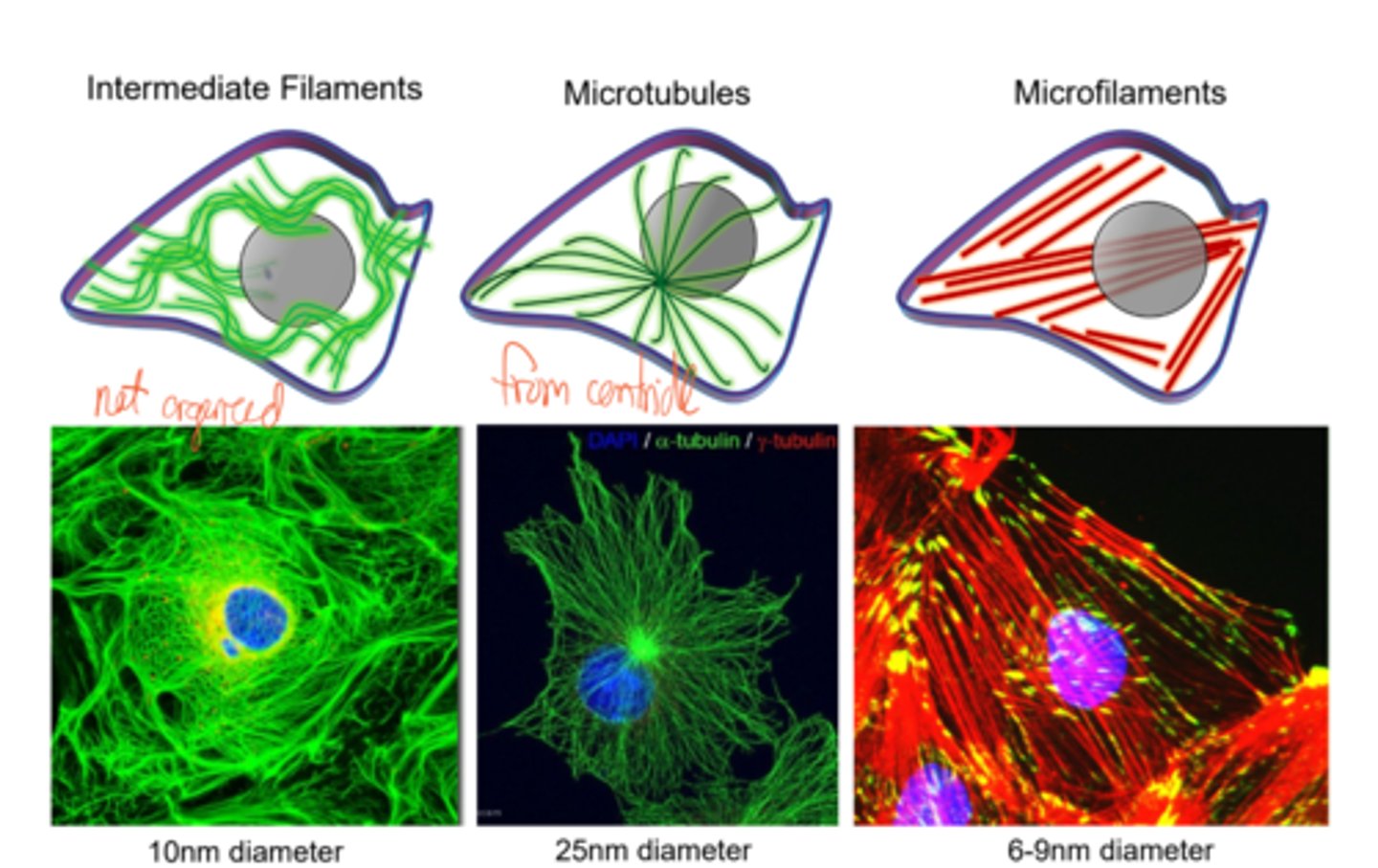
What is homeostasis?
The maintenance of stable conditions in the internal environment.
The internal environment refers to the extracellular space that does NOT face the outside world.